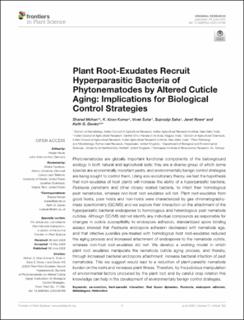| dc.contributor.author | Mohan, Sharad | |
| dc.contributor.author | Kumar, K. Kiran | |
| dc.contributor.author | Sutar, Vivek | |
| dc.contributor.author | Saha, Supradip | |
| dc.contributor.author | Rowe, Janet | |
| dc.contributor.author | Davies, Keith | |
| dc.date.accessioned | 2021-02-08T15:48:21Z | |
| dc.date.available | 2021-02-08T15:48:21Z | |
| dc.date.created | 2020-08-27T12:18:23Z | |
| dc.date.issued | 2020-06-09 | |
| dc.identifier.citation | Frontiers in Plant Science. 2020, 11 1-10. | en_US |
| dc.identifier.issn | 1664-462X | |
| dc.identifier.uri | https://hdl.handle.net/11250/2726695 | |
| dc.description.abstract | Phytonematodes are globally important functional components of the belowground ecology in both natural and agricultural soils; they are a diverse group of which some species are economically important pests, and environmentally benign control strategies are being sought to control them. Using eco-evolutionary theory, we test the hypothesis that root-exudates of host plants will increase the ability of a hyperparasitic bacteria, Pasteuria penetrans and other closely related bacteria, to infect their homologous pest nematodes, whereas non-host root exudates will not. Plant root-exudates from good hosts, poor hosts and non-hosts were characterized by gas chromatographymass spectrometry (GC/MS) and we explore their interaction on the attachment of the hyperparasitic bacterial endospores to homologous and heterologous pest nematode cuticles. Although GC/MS did not identify any individual compounds as responsible for changes in cuticle susceptibility to endospore adhesion, standardized spore binding assays showed that Pasteuria endospore adhesion decreased with nematode age, and that infective juveniles pre-treated with homologous host root-exudates reduced the aging process and increased attachment of endospores to the nematode cuticle, whereas non-host root-exudates did not. We develop a working model in which plant root exudates manipulate the nematode cuticle aging process, and thereby, through increased bacterial endospore attachment, increase bacterial infection of pest nematodes. This we suggest would lead to a reduction of plant-parasitic nematode burden on the roots and increases plant fitness. Therefore, by the judicious manipulation of environmental factors produced by the plant root and by careful crop rotation this knowledge can help in the development of environmentally benign control strategies. | en_US |
| dc.language.iso | eng | en_US |
| dc.publisher | Frontiers Media S.A. | en_US |
| dc.rights | Navngivelse 4.0 Internasjonal | * |
| dc.rights.uri | http://creativecommons.org/licenses/by/4.0/deed.no | * |
| dc.title | Plant root-exudates recruit hyperparasitic bacteria of phytonematodes by altered cuticle aging: Implications for biological control strategies | en_US |
| dc.type | Peer reviewed | en_US |
| dc.type | Journal article | en_US |
| dc.description.version | publishedVersion | en_US |
| dc.rights.holder | Copyright © 2020 Mohan, Kiran Kumar, Sutar, Saha, Rowe and Davies | en_US |
| dc.source.pagenumber | 1-10 | en_US |
| dc.source.volume | 11 | en_US |
| dc.source.journal | Frontiers in Plant Science | en_US |
| dc.identifier.doi | 10.3389/fpls.2020.00763 | |
| dc.identifier.cristin | 1825499 | |
| dc.source.articlenumber | 763 | en_US |
| cristin.ispublished | true | |
| cristin.fulltext | original | |
| cristin.qualitycode | 2 | |

